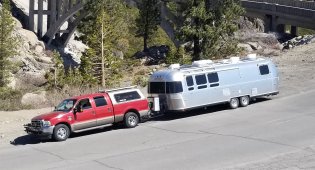I have two 200W panels on the roof of my 21' class C Toyota RV, which has an aluminum roof. I mounted them on the flat part of the roof about 1' before the roof slopes to the over-cab, hoping to reduce wind drag.
Now I'm thinking about installing two 100W panels, but the only space left is over the cab.
I'm wondering: do you think the wind drag on these angled panels would significantly reduce MPG? Also, I mounted with VHB tape, which seems to work well with the aluminum roof--would the pull on a panel over the cab be much greater than on the flat part of the roof, and would VHB still be sufficient? Typical speed is 60mph, might go 70-75 if I were in a hurry.
THANKS!
Now I'm thinking about installing two 100W panels, but the only space left is over the cab.
I'm wondering: do you think the wind drag on these angled panels would significantly reduce MPG? Also, I mounted with VHB tape, which seems to work well with the aluminum roof--would the pull on a panel over the cab be much greater than on the flat part of the roof, and would VHB still be sufficient? Typical speed is 60mph, might go 70-75 if I were in a hurry.
THANKS!



